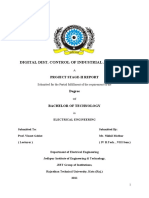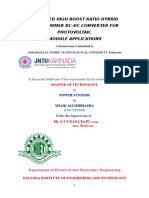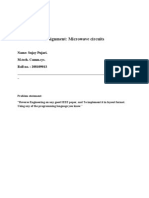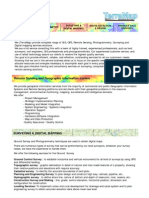Coventor Ware
Coventor Ware
Uploaded by
sujay pujariCopyright:
Available Formats
Coventor Ware
Coventor Ware
Uploaded by
sujay pujariOriginal Title
Copyright
Available Formats
Share this document
Did you find this document useful?
Is this content inappropriate?
Copyright:
Available Formats
Coventor Ware
Coventor Ware
Uploaded by
sujay pujariCopyright:
Available Formats
Mini Project Report Design of Modified CPW switch using Coventorware
Design of Modified CPW switch using Coventorware
MINI PROJECT REPORT
Submitted as part of the coursework
of
Master of Technology
In
COMMUNICATION SYSTEMS
Of
NATIONAL INSTITUTE OF TECHNOLOGY, TIRUCHIRAPPALLI
By
SUJAY PUJARI (208109013)
Department Of Electronics and Communication Engineering
National Institute of Technology
Tiruchirappalli - 620 015
2010
Dept. of ECE, NIT Trichy 1
Mini Project Report Design of Modified CPW switch using Coventorware
NATIONAL INSTITUTE OF TECHNOLOGY
TIRUCHIRAPPALLI, TAMIL NADU – 620 015
DEPARTMENT OF ELECTRONICS AND COMMUNICATION ENGINEERING
CERTIFICATE
Certified that the mini project work titled “Cesign of
modified CPW switch using Coventorware is a
bonafide report of the mini project done by Srijith K
(208109015) of second semester M.Tech in
Communication Systems of the National Institute of
Technology, Tiruchirappalli during the academic year
2010.
Dr.S.Raghavan
Project Guide
Place : Tiruchirappalli
Dept. of ECE, NIT Trichy 2
Mini Project Report Design of Modified CPW switch using Coventorware
Date :
ACKNOWLEDGEMENT
First of all I would like to thank God almighty for his divine grace and blessings
throughout this project.
I wish to thank my Project Guide, Dr.S.Raghavan for his guidance he showed us right
through every stage of the project, from the initial conception to final design and
simulation.
I would also like to extend my sincere thanks to my classmates, friends and family for
their whole-hearted support and encouragement.
Dept. of ECE, NIT Trichy 3
Mini Project Report Design of Modified CPW switch using Coventorware
ABSTRACT
The project aims to design and compare the pull-in voltages of different
flexures. Flexures are structures used to reduce the spring constant of beams.
Different flexures were designed for a fixed-fixed beam using CoventorWare. These
flexures were analyzed using the Analyzer tools of CoventorWare namely
MemElectro, MemMech and CoSolve EM. Pull in voltage analysis was also
performed and the pull in voltage of different flexure designs were compared.
The report will reflect on the principles and procedures of CoventorWare,
design details of flexures and the results and conclusions.
Dept. of ECE, NIT Trichy 4
Mini Project Report Design of Modified CPW switch using Coventorware
CONTENTS
1. INTRODUCTION.........................................................................................01
2. COVENTORWARE......................................................................................02
2.1 INTRODUCTION..................................................................................02
2.2 MPD EDITOR........................................................................................04
2.3 PROCESS EDITOR...............................................................................05
2.4 LAYOUT EDITOR................................................................................07
2.5 MEM ELECTRO....................................................................................10
2.6 MEM MECH..........................................................................................11
2.7 COSOLVE EM.......................................................................................12
3. DESIGN OF CPW SWITCH USING TWO CANTILIVERS......................13
4. RESULTS & CONCLUSIONS.....................................................................14
4.1 RESULTS..............................................................................................14
4.2 CONCLUSIONS....................................................................................15
5. REFERENCES..............................................................................................16
Dept. of ECE, NIT Trichy 5
Mini Project Report Design of Modified CPW switch using Coventorware
1. INTRODUCTION
Switches play a main role in MEMS. These are the basic structures which
are used to implement any RF modules in RF MEMS. There are two type of switches
1. Series switch,
2. Shunt switch
For CPW switch usually fixed fixed beam shunt switch is preferred. In this
project we have designed a CPW switch with two cantilever switches using
COVENTORWARE software.
Dept. of ECE, NIT Trichy 6
Mini Project Report Design of Modified CPW switch using Coventorware
2. COVENTOR
2.1 INTRODUCTION
CoventorWare is an integrated suite of software tools for designing and simulating
MicroElectroMechanical Systems(MEMS).
CoventorWare supports two distinct design flows illustrated in fig 2.1. They are
i) ARCHITECT.
ii) DESIGNER and ANALYZER.
The ARCHITECT module provides a unique system-level approach to MEMS design.
The user assembles a schematic of the MEMS device by selecting and connecting
components from a library of parameterized, MEMS-specific behavioral models.
Upon completing a schematic, the user can simulate various aspects of its physical
behavior. The advantages of this system-level modeling approach include full
parameterization of the design and very fast simulations
Fig 2.1 : Design flow in Coventor
Dept. of ECE, NIT Trichy 7
Mini Project Report Design of Modified CPW switch using Coventorware
The DESIGNER and ANALYZER modules support a physical design flow. The user
starts in DESIGNER by creating a 2-D layout in the Layout Editor. The Solid
Modeler uses the layout, in conjunction with the layer stack information provided in
the Process Editor, to automatically build a 3-D solid model. The user then works in a
3-D view in the Preprocessor to prepare the 3-D model for automatic mesh
generation. After a mesh has been generated, the user can select from a
comprehensive suite of field solvers that simulate the physical behavior of MEMS.
Both design flows require information about the fabrication process as a starting
point, and this information is provided via a Process Editor and the Material
Properties Database. The INTEGRATOR module provides a bridge from detailed 3-D
physical simulations in ANALYZER to the ARCHITECT system-level modeling
environment
Fig 2.2 : Function Manager window
Dept. of ECE, NIT Trichy 8
Mini Project Report Design of Modified CPW switch using Coventorware
The Function Manager window shown in Fig 2.2 is the first to appear. All
CoventorWare functionality is accessed from the Function Manager. It consists of the
following:
Material Properties Database: The first step in creating a design is to enter
the material properties associated with your fabrication process in the Material
Properties Database (MPD). Only the materials that are in the MPD are
accessible in the Process Editor and available for simulations.
Process Editor: The second step in creating a design is to enter a description
of the sequence of steps involved in the fabrication process in the Process
Editor.
Analyzer 3-D Field Solvers: Analyzer provides a comprehensive suite of
3-D solver. With these solvers, you can perform analyses.
2.2 MATERIALS EDITOR
Material Properties Database (MPD) file
Contains commonly used materials for MEMS processing
Includes mechanical, electrical, thermal, fluidic, and other generic material
property values.
Dept. of ECE, NIT Trichy 9
Mini Project Report Design of Modified CPW switch using Coventorware
2.3 PROCESS EDITOR
Coventor uses Surface micromachining
Surface micromachining – addition and removal of sequence of thin film
layers to/from the wafer surface
Sacrificial & structural layers
Depends on the ability to release/dissolve the sacrificial layers while
preserving the integrity of structural layers
build or edit a simulated process flow that models the fabrication process to be
used
The 2-D mask definitions in the layout are combined with the depth
information in the process to create a model.
Dept. of ECE, NIT Trichy 10
Mini Project Report Design of Modified CPW switch using Coventorware
Dept. of ECE, NIT Trichy 11
Mini Project Report Design of Modified CPW switch using Coventorware
Dept. of ECE, NIT Trichy 12
Mini Project Report Design of Modified CPW switch using Coventorware
2.4 LAYOUT EDITOR
Purpose: Generate 2-D masks
Tasks performed by icons, point-and-click mouse functionality, the menu bar
and drop-down menus, and Terminal Window commands.
Graphic tool
User interface dialogs
Drawing area
Terminal window
Icons
Menu selections
Dept. of ECE, NIT Trichy 13
Mini Project Report Design of Modified CPW switch using Coventorware
Dept. of ECE, NIT Trichy 14
Mini Project Report Design of Modified CPW switch using Coventorware
3D MODEL GENERATION:
Dept. of ECE, NIT Trichy 15
Mini Project Report Design of Modified CPW switch using Coventorware
2.5 MEM ELECTRO
With the CoventorWare solvers, the user can run various
simulations on a model created and meshed in the Preprocessor or
on a model imported and converted to the CoventorWare file
format. CoventorWare’s electrostatic solver, MemElectro, can
compute a matrix of capacitance and conductance values or can
compute forces on conductors and dielectrics for MEMS designs.
MemElectro applies selected solver settings and boundary
conditions and computes the appropriate results. The output may be
viewed in a tabular form or rendered in three dimensions over the
structure’s domain in the Visualizer.
The flow chart in Fig 2.11 provides an overview of the MemElectro
functions.
Dept. of ECE, NIT Trichy 16
Mini Project Report Design of Modified CPW switch using Coventorware
Fig 2.11 : Functions of MemElectro
2.6 MEM MECH
MemMech is CoventorWare’s mechanical solver, which computes
displacement and stress results. The user applies the boundary
conditions set in solver dialog, and the solver generates output that
may be viewed in a tabular form or rendered in three dimensions
over the structure’s domain in the Visualizer. The flow chart in Fig
2.12 provides an overview of the MemMech functions:
Dept. of ECE, NIT Trichy 17
Mini Project Report Design of Modified CPW switch using Coventorware
Fig 2.12 : Functions of MemMech
2.7 COSOLVE EM
CoSolveEM provides the capability of coupled quasi-steady
electromechanical analysis. A typical application is the analysis of
the electrostatic actuation of restrained mechanical structures.
MemElectro provides the electrostatic analysis, and MemMech
provides the mechanical analysis. CoSolve uses an iterative
Dept. of ECE, NIT Trichy 18
Mini Project Report Design of Modified CPW switch using Coventorware
procedure to maintain consistency between the two solutions, that
is, the mechanical deformation is correct for the applied
electrostatic forcing. The most common application is determination
of the so-called "pull-in" voltage, but other applications are useful as
well, including investigation of contact and lift-off behavior and
electrostatic spring softening. Typically, simulations are conducted
in the form of a traversal of a trajectory of actuation voltages (or
charges), but a single excitation condition can also be investigated.
The setup of a CoSolve simulation requires that MemMech be set up
for the mechanical analysis parameters and boundary conditions
and that MemElectro be set up for the electrostatic analysis
parameters and boundary conditions.The user should set
parameters for these solvers before setting CoSolve parameters.
3. DESIGN OF CPW SWITCH WITH TWO CANTILEVERS
Layout:
Dept. of ECE, NIT Trichy 19
Mini Project Report Design of Modified CPW switch using Coventorware
3D model:
4. RESULTS & CONCLUSION
Dept. of ECE, NIT Trichy 20
Mini Project Report Design of Modified CPW switch using Coventorware
MemMech analysis:
Pullin Voltage Analysis: Pull in voltage=13.2v
CONCLUSION:
Dept. of ECE, NIT Trichy 21
Mini Project Report Design of Modified CPW switch using Coventorware
The original CPW switch was modified with two cantilevers and its
pullin voltage was obtained.
Dept. of ECE, NIT Trichy 22
Mini Project Report Design of Modified CPW switch using Coventorware
5. REFERENCES
1. MEMS Design and Analysis Tutorials, Vol. 1, Physical and System Level
Design, CoventorWareTM 2008; www.coventor.com
2. CoventorWare DesignerTM Version 2008; Reference: MEMS and
Microsystems Physical Design; www.coventor.com
Dept. of ECE, NIT Trichy 23
You might also like
- Iot Project ReportDocument18 pagesIot Project ReportpassionproblemNo ratings yet
- Capstone Final ReportDocument32 pagesCapstone Final ReportJeff Kim100% (1)
- Chapter 4 - Isometric DrawingDocument14 pagesChapter 4 - Isometric DrawingEvioKim0% (1)
- Umar ProposalDocument20 pagesUmar ProposalUmar farouk alauddenNo ratings yet
- Rising Power Supply PaperDocument26 pagesRising Power Supply PaperManoj EmmidesettyNo ratings yet
- 414 Report - Substation Monitoring Systeam (A) ..Document93 pages414 Report - Substation Monitoring Systeam (A) ..ayushgamit467No ratings yet
- Thesis FinalDocument75 pagesThesis FinalSHARIZA DAYANA RODRIGUEZ URRESTANo ratings yet
- CT 2017 1305962Document90 pagesCT 2017 1305962ali ghalibNo ratings yet
- Fire Fighting Robotic Vehicle: Project OnDocument25 pagesFire Fighting Robotic Vehicle: Project OnRuman Guha NiyogiNo ratings yet
- Iot Based Transformer Monitoring System: Savitribai Phule Pune UniversityDocument69 pagesIot Based Transformer Monitoring System: Savitribai Phule Pune UniversityyashNo ratings yet
- 412-Report-Induction Motor Protection SysteamDocument97 pages412-Report-Induction Motor Protection Systeamarishmomin44No ratings yet
- Internship.sravani429Document21 pagesInternship.sravani42922315a0429No ratings yet
- Environmental Monitoring SystemDocument26 pagesEnvironmental Monitoring SystemMonish NaiduNo ratings yet
- PLC RDocument36 pagesPLC RPrudhvi AllaNo ratings yet
- A Project Report OnDocument84 pagesA Project Report OnyaminiNo ratings yet
- A Project Report On: Devi Mahalaxmi Polytechnic College, TitwalaDocument33 pagesA Project Report On: Devi Mahalaxmi Polytechnic College, Titwalaprashant mhatreNo ratings yet
- Industrial Fault Indication System Using Avr MicrocontrollerDocument15 pagesIndustrial Fault Indication System Using Avr Microcontrollersri_palakolanuNo ratings yet
- A Project Report ON: The Guidance ofDocument28 pagesA Project Report ON: The Guidance ofRupam OnkarNo ratings yet
- Nikhil Project Report (Viii Sem)Document46 pagesNikhil Project Report (Viii Sem)nikhil_mathur10No ratings yet
- Distributed Autonomous Robotic Systems For Co Operative Control IJERTCONV6IS13172Document6 pagesDistributed Autonomous Robotic Systems For Co Operative Control IJERTCONV6IS13172tekato kikutaNo ratings yet
- ES - Document (1) MVR 1Document25 pagesES - Document (1) MVR 1akhilapanga428No ratings yet
- Comparisons Between Different Hybrid Statistical Models For Accurate Forecasting of Photovoltaic Systems PowerDocument125 pagesComparisons Between Different Hybrid Statistical Models For Accurate Forecasting of Photovoltaic Systems PowerandcretiNo ratings yet
- 109EC0240Document56 pages109EC0240rohitha avulaNo ratings yet
- How To Use IEC 61850 in Protection and AutomationDocument11 pagesHow To Use IEC 61850 in Protection and AutomationluhusapaNo ratings yet
- AaryanDocument24 pagesAaryanakaykumar7296No ratings yet
- Report FormateDocument12 pagesReport FormateanjaliawasthiworkNo ratings yet
- Project DocumentDocument70 pagesProject Documentafifashaik169No ratings yet
- Report Phase 2Document30 pagesReport Phase 2balaji xeroxNo ratings yet
- Development of Graphical User Interface For Microwave Filter DesignDocument127 pagesDevelopment of Graphical User Interface For Microwave Filter DesignMian Muhammad Ubaid UllahNo ratings yet
- M.tech ECE Shivaram ResumeDocument3 pagesM.tech ECE Shivaram ResumeM Das100% (1)
- N217 DocumentationDocument108 pagesN217 DocumentationSyed MohiuddinNo ratings yet
- Digital Clock With Temperature and Humidity Monitoring System !Document35 pagesDigital Clock With Temperature and Humidity Monitoring System !raghu charkhaNo ratings yet
- Smart Energy Monitoring System - Project Final ReportDocument11 pagesSmart Energy Monitoring System - Project Final Reportsethdesilva.clNo ratings yet
- Group 16 PrePaid Energy MeterDocument43 pagesGroup 16 PrePaid Energy Meterannu13688No ratings yet
- PankajDocument10 pagesPankajG12- Pankaj Dinkar GunjikarNo ratings yet
- CG Report2345Document37 pagesCG Report2345mohan562356No ratings yet
- Web-Based Instructional Information Management SystemDocument40 pagesWeb-Based Instructional Information Management Systemsejal2008No ratings yet
- Persistence of Vision Display IJERTV10IS0901991Document4 pagesPersistence of Vision Display IJERTV10IS0901991best boy bulshaawiNo ratings yet
- Fault Detection in Transmission Line Using GSM Technology 4301,4304,4313Document67 pagesFault Detection in Transmission Line Using GSM Technology 4301,4304,4313naveen gNo ratings yet
- Lin Bus Based Data Acquisition and Control System Using PsocDocument47 pagesLin Bus Based Data Acquisition and Control System Using PsocMani KandanNo ratings yet
- Energy Meter ProjectDocument14 pagesEnergy Meter ProjectShiva Pavan100% (1)
- Cover PageDocument11 pagesCover PageVidhyaNo ratings yet
- Final Form of SynopsisDocument7 pagesFinal Form of SynopsisAbbas JaveedNo ratings yet
- Digital Distance Relay Modeling and Testing Using LabVIEW and MATLAB SimulinkDocument55 pagesDigital Distance Relay Modeling and Testing Using LabVIEW and MATLAB SimulinkK Vijay Bhaskar ReddyNo ratings yet
- My ProjectDocument58 pagesMy ProjectGreenCornerTech NlrNo ratings yet
- Iot - Based - Train - Accident - and - Location - Tracking - SystemDocument5 pagesIot - Based - Train - Accident - and - Location - Tracking - Systemmai.sangNo ratings yet
- GR11Document50 pagesGR11Arif TirtaNo ratings yet
- Anzam Project 1Document45 pagesAnzam Project 1HEART SPORTSNo ratings yet
- Mikolaj Iwaniec ThesisDocument150 pagesMikolaj Iwaniec ThesisMikołaj IwaniecNo ratings yet
- Project phaseII ReportDocument42 pagesProject phaseII ReportKarthik SarodeNo ratings yet
- ALU Project ReportDocument36 pagesALU Project Reportmastersabarish333No ratings yet
- Final ProjectDocument16 pagesFinal ProjectRitesh NandurkarNo ratings yet
- Raghu - Rajappa MasterThesis ReportDocument95 pagesRaghu - Rajappa MasterThesis ReportAlex FruhtmanNo ratings yet
- Implementing The CANopen Protocol and A New Interface With Communication Via Bluetooth in The BioBikeDocument25 pagesImplementing The CANopen Protocol and A New Interface With Communication Via Bluetooth in The BioBikeVedant PrustyNo ratings yet
- DHANAREDDY (2)Document23 pagesDHANAREDDY (2)dhanarama924No ratings yet
- Ranjeeth 2Document35 pagesRanjeeth 2lazybug250No ratings yet
- Design Automation of Steam Turbine Diaphragms in NXDocument85 pagesDesign Automation of Steam Turbine Diaphragms in NXyannikNo ratings yet
- Advanced High Boost Ratio Hybrid Transformer DCDocument12 pagesAdvanced High Boost Ratio Hybrid Transformer DCvidya sagarNo ratings yet
- Cover Page ADocument11 pagesCover Page AVidhyaNo ratings yet
- Bell IotDocument30 pagesBell IotAezam Shareef عازم شريفNo ratings yet
- Nonlinear Traction Control Design for Parallel Hybrid VehiclesFrom EverandNonlinear Traction Control Design for Parallel Hybrid VehiclesNo ratings yet
- Pspice: by Sujay PujariDocument31 pagesPspice: by Sujay Pujarisujay pujariNo ratings yet
- Optical Signal ProcessingDocument38 pagesOptical Signal Processingsujay pujariNo ratings yet
- Assignment: Microwave Circuits: Name: Sujay Pujari. M.tech. Comm - Sys. Roll No.: 208109013Document26 pagesAssignment: Microwave Circuits: Name: Sujay Pujari. M.tech. Comm - Sys. Roll No.: 208109013sujay pujariNo ratings yet
- Discriminant Analysis StatisticsDocument18 pagesDiscriminant Analysis Statisticssujay pujariNo ratings yet
- BluetoothDocument70 pagesBluetoothsujay pujariNo ratings yet
- Lesion Detection in Mammogram Lesion Detection in Mammogram Based On Multiresolution AnalysisDocument16 pagesLesion Detection in Mammogram Lesion Detection in Mammogram Based On Multiresolution Analysissujay pujariNo ratings yet
- Lesion Detection in Mammogram Based On Multiresolution AnalysisDocument17 pagesLesion Detection in Mammogram Based On Multiresolution Analysissujay pujariNo ratings yet
- Modbus Based DCS - Distributed Control SystemDocument70 pagesModbus Based DCS - Distributed Control Systemsujay pujari100% (1)
- Advanced Photoshop Issue 121Document100 pagesAdvanced Photoshop Issue 121Dipesh BardoliaNo ratings yet
- Cad Profile PDFDocument11 pagesCad Profile PDFAnonymous FPAzsNAXLNo ratings yet
- FinalExam SolutionDocument11 pagesFinalExam SolutionpranavjibhakateNo ratings yet
- AutoCAD ShortcutsDocument11 pagesAutoCAD Shortcutss3dul0usgamingNo ratings yet
- Spring 2023 Undergraduate Admission Guide For International StudentsDocument16 pagesSpring 2023 Undergraduate Admission Guide For International StudentsAneulbiNo ratings yet
- AutoCAD Civil 3D Engineering Survey Plan Processing Guide PDFDocument77 pagesAutoCAD Civil 3D Engineering Survey Plan Processing Guide PDFzain aliNo ratings yet
- IB CS HL Case Study TermsDocument4 pagesIB CS HL Case Study TermsSaihielBakshiNo ratings yet
- Sicotj 3 16Document10 pagesSicotj 3 16OstazNo ratings yet
- Sculpteo Design Guidelines PDFDocument34 pagesSculpteo Design Guidelines PDFMehran ZaryounNo ratings yet
- Computer Science Grade 3 Third TermDocument4 pagesComputer Science Grade 3 Third Termpriyanka choudharyNo ratings yet
- Finite Element Investigation of Corrugated Steel Pipe With Extreme Corrosion Under Shallow CoverDocument11 pagesFinite Element Investigation of Corrugated Steel Pipe With Extreme Corrosion Under Shallow Cover武飞No ratings yet
- Augmented Reality in Industry 4.0Document7 pagesAugmented Reality in Industry 4.0Jack 123No ratings yet
- Isometric Projections NMD PDFDocument48 pagesIsometric Projections NMD PDFNaman Dave100% (5)
- How To Create A Kids Room With 3ds Max 2d 3d Tutorials PDFDocument54 pagesHow To Create A Kids Room With 3ds Max 2d 3d Tutorials PDFbrumim-1No ratings yet
- The Visual Elements Have A Relationship To One AnotherDocument5 pagesThe Visual Elements Have A Relationship To One AnotherRhea PaguigbaoNo ratings yet
- Terramap BrochureDocument3 pagesTerramap BrochureponyanNo ratings yet
- User Guide For HXSim v3.0Document63 pagesUser Guide For HXSim v3.0Ramesh K KarthickNo ratings yet
- Tuto - Zbrush To Blender Ver 1.0Document14 pagesTuto - Zbrush To Blender Ver 1.0cagetakoko12100% (1)
- 3D Scientific Visualization With Blender (PDFDrive)Document121 pages3D Scientific Visualization With Blender (PDFDrive)Mrzim GuglNo ratings yet
- 3d DesignersDocument64 pages3d Designersmalwina.wenskaNo ratings yet
- An Autonomous Mobile Robot With A 3D Laser Range Finder For 3D Exploration and Digitalization of Indoor EnvironmentsDocument18 pagesAn Autonomous Mobile Robot With A 3D Laser Range Finder For 3D Exploration and Digitalization of Indoor EnvironmentsCocias AdrianNo ratings yet
- Syllabus Revit Architecture FundamentalsDocument3 pagesSyllabus Revit Architecture FundamentalsBishwajit ChowdhuryNo ratings yet
- BIM Maturity MatrixDocument7 pagesBIM Maturity MatrixRicardo FreitasNo ratings yet
- FHGJHDocument32 pagesFHGJHthrilok SuryaNo ratings yet
- AutoCAD Shortcu-WPS OfficeDocument19 pagesAutoCAD Shortcu-WPS OfficeJefee GualvezNo ratings yet
- How To Create A Sketch Render in ArchicadDocument10 pagesHow To Create A Sketch Render in ArchicadRuben MolinaNo ratings yet
- Artlantis WorkbookDocument218 pagesArtlantis WorkbookgithireNo ratings yet
- Studio EM WebDocument2 pagesStudio EM WebjohanNo ratings yet
- Practical and Technical Skills: Grade 6Document12 pagesPractical and Technical Skills: Grade 6Fathima FazmilaNo ratings yet

































































































